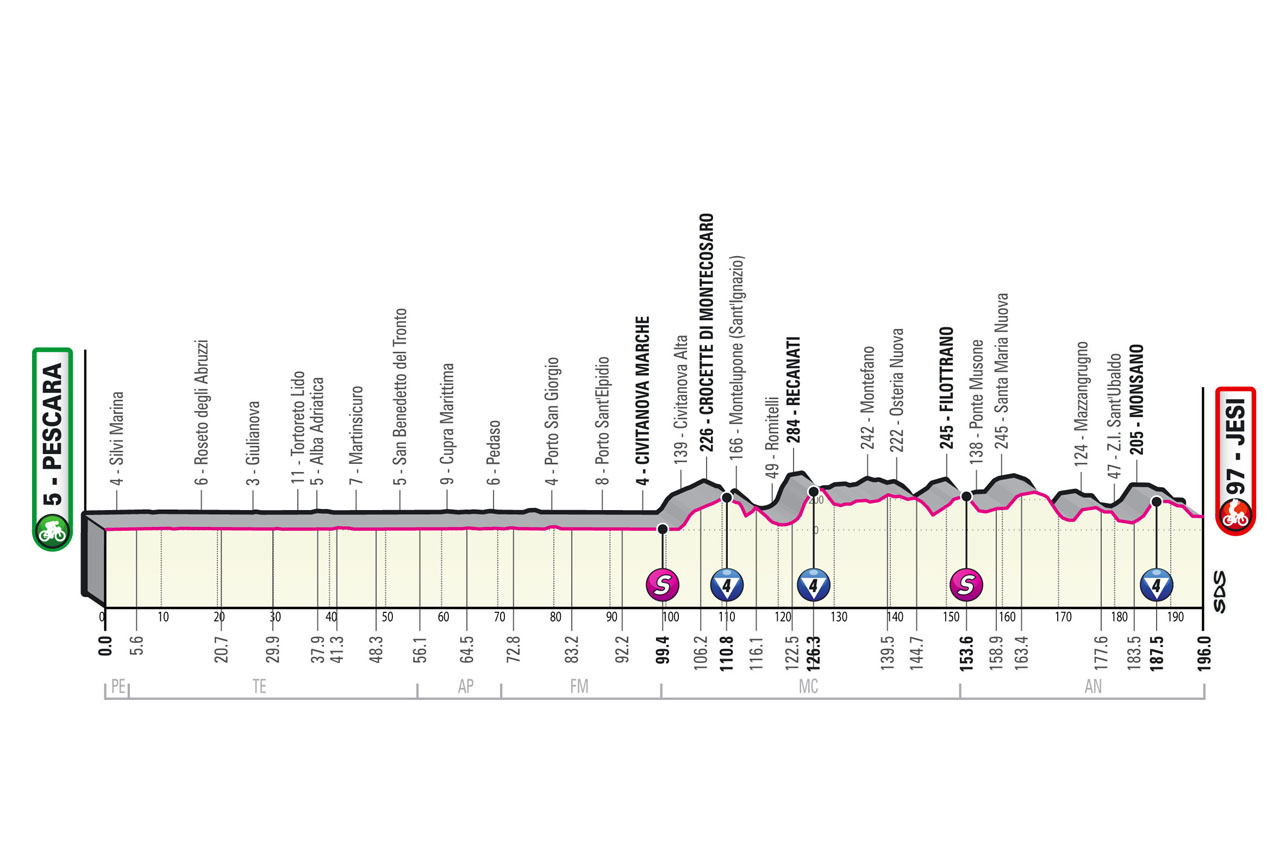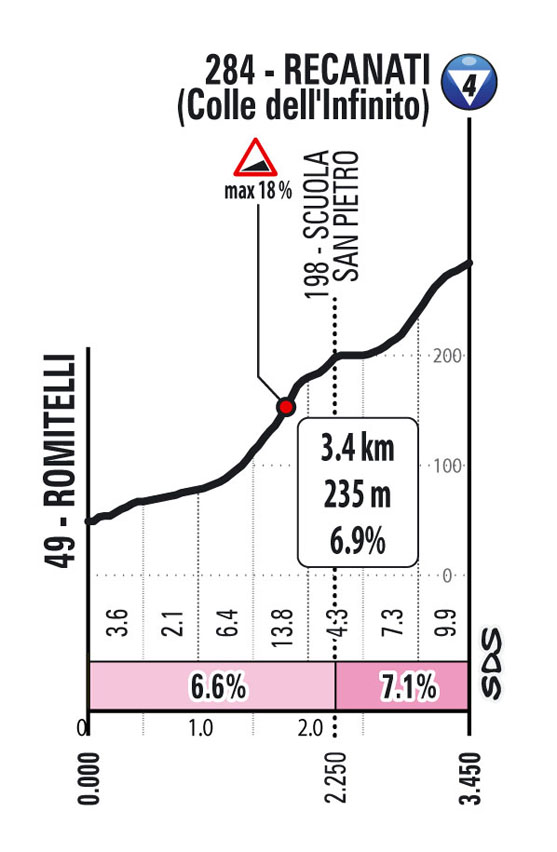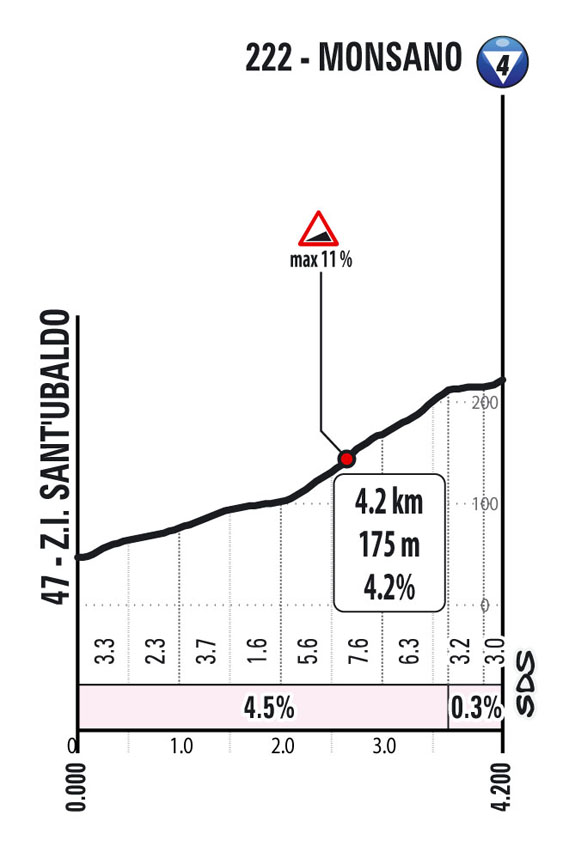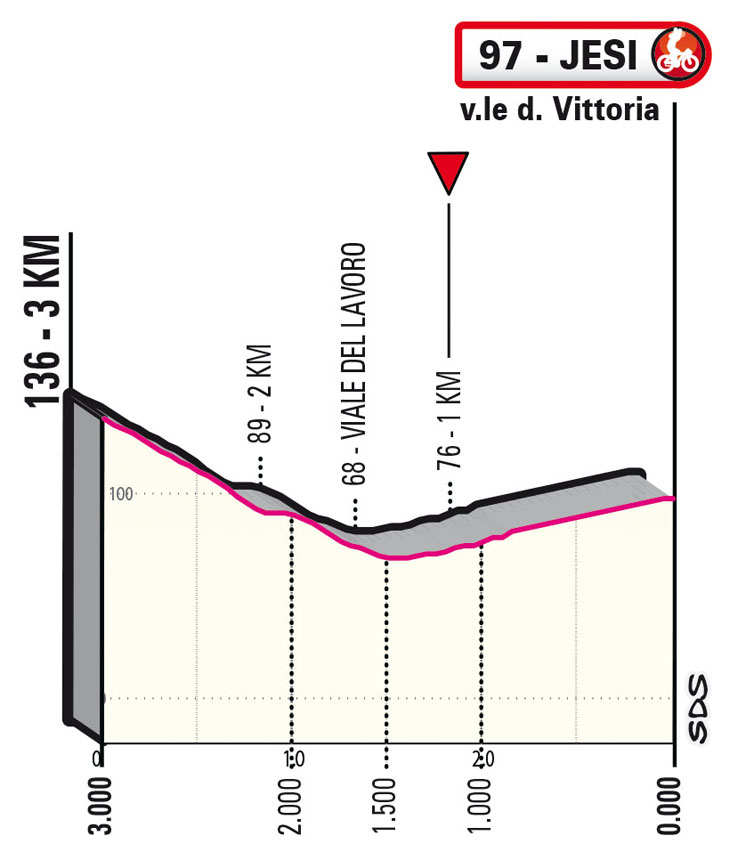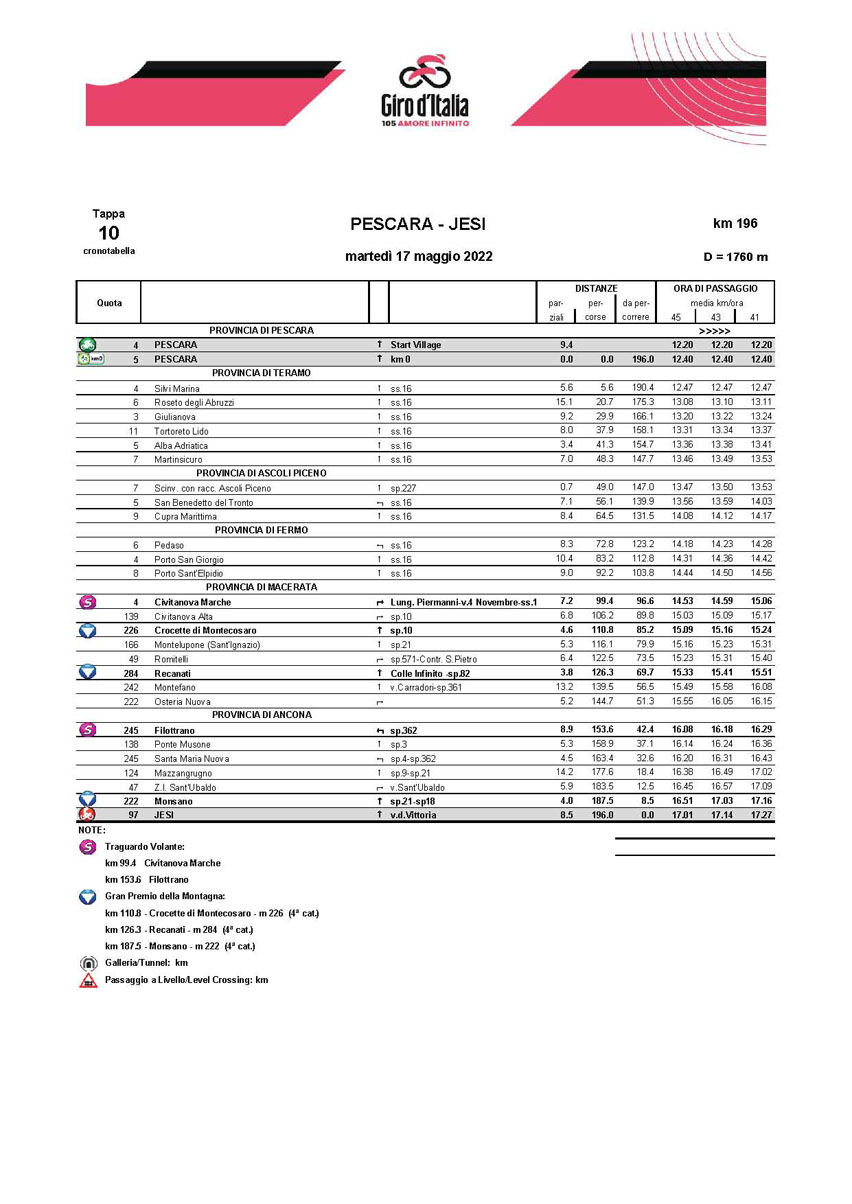profile
map
technical info
The route
The stage is clearly divided into two parts. It begins pan-flat along the Statale Adriatica, where the main obstacles along the course are the ones typically found in urban areas. In the second half, conversely, the route takes in a succession of mild and steep ascents or even ‘walls’, with no pause for breath. As the profile changes, the roads become narrower and steeper, and slightly damaged at points. The course then takes in consecutive ascents to Civitanova Alta (up to Crocette di Montecosaro), Recanati, Filottrano, Santa Maria Nova and Monsano. Past Monsano, the finish will be just 9 km away.
Final kilometres
The route drops down quickly on wide roads into Jesi, with approximately 1,400 m to go. A right-hander leads into the home straight, on an average 2% incline. The finish line lies on tarmac.
start / finish
climb detail
final kilometres
itinerary timetable
tourist info
Host city:
Pescara
Touristic Information
The first thing we invite you to do when you arrive in the city is to climb the Ponte del Mare, a light jewel placed where the Pescara river embraces the sea. This is how “the surprise of green, rich Pescara, which at times has the color of malachite … and you feel the sea light of all things” opens to the eye. It is often defined as brand new but its oldest part has its roots in the foundations of the sixteenth-century fortress that presided over the river. Its most recent part, born in 1806 around the chapel containing a miraculous image of the Virgin of which today remains the high Baroque bell tower, stretches north of Pescara in the narrow and fertile strip of land between the hills and the protected sea, on the background, from “those mountains that cannot be ignored, monumental and free” which are the Gran Sasso and the Majella. A land of great character, “where you seem to arrive suddenly, crossing the steep gorges and the wide plateaus of the Apennines”, a land of furious aspirations and disarming sensuality which fed the poetry of Gabriele d’Annunzio and acute and cutting reflection of Ennio Flaiano, today Pescara continues to grow, innovative and enterprising as a gateway to the Adriatic.
Gastronomy
A rich variety of typical produits and characteristic receipts build the gastronomic tradition of Pescara.
Cardone’s broth is a must in all Christmas’ menus.
Besides the traditional maccheroni alla chitarra, a remarkable unique receipt is pasta alla mugnaia, formerly known as molinara due to the water mills scattered on the Fino river’s bank since the Middle Ages, producing the flour that, mixed with water, was the only one ingredient of this receipt.
Within the sea planet, the delicious fish broth is the top tier. In the kingdom of meat dishes, sheep meat arrosticini, commonly known as rustell, conquer the highest rank.
Speaking of cheese, a special mention goes to Farindola’s pecorino. Already famous in Roman times (Pliny the Elder considered it to be one of the most delicious cheeses ever served at the Emperor’s table). It risked to disappear around the end of the last century, due to the mass migrations after the Great War. The preparation is an exclusive prerogative of women, who pass the tradition on, safeguarding the memory of a cheese which is prepared with pork’s rennet, which makes it tasty, rich and unique in Italy (and, perhaps all over the world).
The bean Tondino del Tavo, with its rounded shape, takes the name of the valley where it is cultivated, and it is considered to be the wealth of the whole community.
Pipindun e ove is a very special side dish, as well as the cipollata. Olive groves covering the hills around Pescara ensure the production of a prestigious oil, an important added value of any single receipt. It is ideal to taste it on a slice of bread!
As for the desserts, a primacy of honor is to be recognized to Parrozzo. Originally a poor dish whose name was pan rozzo, it was prepared with corn flour to imitate the presence of eggs, cooked in a wood fired oven. Only in 1920 the baker Luigi D’Amico enriched it by adding eggs, almond flour and citrus flavor, covered it all with chocolate to evoke the image of a slightly burnt bread from a wood fired oven, and gave it its characteristic hemispherical shape. That is how Parrozzo was born, a simple yet fine sweet, “chiù doce de qualunqua cosa ddòce” as Gabriele d’Annunzio wrote and as still nowadays reads on its package box.
Beverages
The excellence of the grapevine and wines from the land of Pescara, whose standing stretches across centuries since the Middle Ages, is due to its hilly terrain whose natural, climatic, physical and chemical characteristics. These determine a terroir that allows the production of a unique and specific wine, expression of the identity of the area.
The noble VALENTINI family, of Spanish ancestry, gives its name to an ancient cellar, the most prestigious in the whole Abruzzo region and famous in Italy and around the world for the high quality of its wines: Montepulciano, Cerasuolo and Trebbiano d’Abruzzo. The latter was awarded the title of Best Wine of Italy in 2012.
The wine art of the BOSCO’s cellar began in 1897 on the Pescara hills, from which the “red from the hills” originates. The vineyards guarantee the production of excellent wines, mainly red ones. The BOSCO’s cellar has been exporting wines steadily for 50 years worldwide. Over 60 percent of its annual production is currently destined abroad.
“Total quality, from the bunch to the glass” is the motto of the ZACCAGNINI’s cellar, which produces up to 3 million bottles per year destined for internal and international markets. The art of wine is intended as a true work of art: even the wine bottle label was designed by Pietro Cascella.
The vineyards of the VALLE REALE’s cellar, located on the heights nearby, covered by woods, rich in biodiversity and embraced by natural parks, give life to two different viticultures, due to the variety of climes, all characterized by the considerable thermal excursions that allow the grapes to maintain their essences and their freshness unaltered.
Also of note are the DE FERMO’s cellar, from biodynamic vineyards, and the Cantina del PODERE CASTORANI, taken over in 1998 by former Formula 1 driver Jarno Trulli.
The lands of Pescara give birth to two liqueurs of great stature: AURUM, obtained from the essence of a variety of Abruzzo oranges mixed with aged Italian brandy, owes its name to two Latin words that emphasize its color and taste: Aurum (gold ) and Aurantium (orange), and CENTERBA TORO, obtained from the maceration of herbs from the Abruzzo mountains and precious oriental spices, today highly appreciated after meals and once also used as a medicine due to its high alcohol content (70 °).
Main sights
The journey through the city through its most significant places starts from the monumental Government Palace decorated with precious marbles and collections of works of art including The Daughter of Iorio by Francesco Paolo Michetti, large tempera on sackcloths sewn together and from which Gabriele d’Annunzio will be inspired by his famous tragedy of the same name: the city considers it a common heritage and in it recognizes the strength of its roots and its anthropological measure. Immediately after, you are ready to cross the Risorgimento Bridge on the river which is now approaching the sea. We are about to immerse ourselves in the oldest Pescara and meet the birthplace of the Cascella, Ennio Flaiano and Gabriele d’Annunzio in via Manthonè and in via delle Caserme where the Museum of the People of Abruzzo is one of the national realities specialized in the study of aspects ethno-anthropological of the history of Abruzzo and of the peoples of Central Italy. Only a few steps to arrive in that Piazza Garibaldi where, in the Circolo Aternino, the best intelligences of Pescara in the early 1900s were already nourishing the vision of the contemporary metropolitan city of Pescara. Further south await the delightful liberty districts immersed in the d’Annunzio pine forest where the Aurum, an architectural complex of great value, from an innovative holiday center for the nascent bourgeoisie of Pescara in the first decade of 1900, first evolved into that visionary factory of liqueurs that for the first time in Italy made a synthesis of product innovation and culture and now aspires to become a cultural industry, at the service of young startups looking to Europe. On the way you will come across the brand new Museum of the Nineteenth Century which houses a precious collection of Italian and French nineteenth-century works located in the historic building of the former Bank of Italy. And then proceed, regaining the splendid promenade on the Riviera where the Sea Museum, with the new immersive displays, will soon be a point of reference for the history and scientific and historical-anthropological future of the Adriatic Sea. Following the skyline of the Ponte del Mare you will find L’Approdo alla nave, the white ship of Pietro Cascella, open to the sea, directly on the beach, with the bow turned towards the voyage like the people of Pescara, but always ready to return.
Through the intimate Corso Umberto you can stop and admire the delicate beauty of Villa Urania, a nineteenth-century villa in an eclectic style, which houses the Paparella Treccia Devlet Collection, consisting of 151 selected masterpieces of Castelli’s artistic majolica. But later, after having been pleasantly disoriented in front of the Gothic lines of the Basilica of the Sacred Heart, one is ready to look to the future reinterpreted through the signs of contemporary art in the IMAGO Museum, in the splendid monumental building of the EX Banco di Napoli which dialogues, in a game of eras that attract and overcome each other, with the Liberty lines of the refined Palazzetto Imperato.
The new Central Station is a stone’s throw away, but Pescara offers other precious treasures of nineteenth-century, liberty and post-modern beauty and is certain that you will come back very soon.
Jesi
Touristic Information
Jesi (40,000 inhabitants) situated partly on a plain and partly on a hillock to the left of the Esino river, half way from the Adriatic Sea and the Marche Apennines. Jesi is the most important city in the river Esino valley, embracing about 20 hamlets. UNESCO has defined it as an ‘exemplar city’ thanks to the exceptional preservation of its oldest memories. Jesi was the birthplace of illustrious figures such as the Swabian Emperor Frederick II Hohenstaufen, the humanist Angelo Colocci and the composer Giovan Battista Pergolesi, but over the centuries it has also been home to important names who have left a valuable cultural heritage such as the Siena-born architect Francesco di Giorgio Martini and the Venetian painter Lorenzo Lotto.
Jesi’s extraordinary sports vocation is recognised at international level, making it the world’s most medalled city (23 medals) in the history of the Olympics. There have been great champions from Jesi, both in fencing, such as Valentina Vezzali, Giovanna Trillini, Stefano Cerioni and Elisa Di Francisca, and in football, first and foremost Roberto Mancini, coach of the Italian national football team.
Gastronomy
Sitting at table and trying the local food … no better way to appreciate the local culture. The flagship pasta dish is a regional version of baked lasagne, the vincisgrassi. Once called “princisgras”, it is made from a 1784 recipe by renowned, Macerata-born chef, Antonio Nebbia. Another local specialty are passatelli, a soft pasta made with parmesan cheese, bread crumbs, eggs and nutmeg, that can be eaten in broth or as pasta, with sauce. As a second course, the porchetta, roast suckling pig, is popular in all of Central Italy. In the Marche, though, rabbit is also prepared this way, ‘in porchetta’, stuffed with wild fennel and bits of pork rind. Other regional favourites are the coniglio in potacchio, roast rabbit seasoned with garlic, sage and rosemary, and the oca arrostita, roast goose, traditionally eaten at harvest time. Specialty bakery products are both sweet and savoury. Early in the year, there are Carnival treats. This area of the Marche is known for the castagnole, small balls of sweet dough, fried, then dusted with confectioner’s sugar, and the cicerchiata, named for the shape of the small chickling pea and made from tiny balls of hand rolled dough, drizzled with honey. The bakery treats for the Feast of St. Joseph are maritozzi. They are like a sweet bread, baked in small oval shapes and decorated with a sugar icing. The pizza al formaggio was always served for breakfast after the Easter mass. This cheese bread is traditionally eaten with home-made salami and an omelette made with a mix of spring herbs. Harvest season is the time for cakes and biscuits ‘al mosto’. In November the fave dei morti are made, a round, slightly flattened biscuit with almonds. The cavallucci or “little horses” biscuits are traditionally made in wintertime. Thick and rich, these treats are stuffed with ‘sapa’, Rum or Marsala, coffee, walnuts, almonds, chocolate, candied fruit, raisins and dried figs. A special delight: the lonza di fico, a dried fig log, with walnuts, almonds and sapa, a sweet, boiled grape-must syrup.
Beverages
But in this land of ours, art also manifests itself in that succulent nectar, straw yellow in color, known as the Verdicchio dei Castelli di Jesi.
The name ‘Verdicchio’ first appeared in 1569 in a notarial deed. It refers to both the grapevine and the grape which turns into a lovely straw yellow when ripe, but retains an evident greenish tinge. The production area covers 24 townships, most of them in the central hills of Ancona Province and a small part in some territories in Macerata Province. ‘Verdicchio dei Castelli di Jesi’ wine is obtained from Verdicchio grapes, an autochthonous variety. Some other authorized, white grape varieties may be added up to a maximum of 15%.
Bouquet: delicate, fresh and fragrant; persistent fruit and floral scents, a hint of green almond.
Palate: dry, elegant, harmonic, with a pleasant, slightly bitter aftertaste.
Designations and typologies DOCG-DOP (Controlled and Guaranteed Designation
of Origin/Protected Designation of Origin): Castelli di Jesi Verdicchio Riserva and Castelli di Jesi Verdicchio Riserva Classico.
Designations and typologies DOC-DOP (Controlled Designation of Origin/Protected Designation of Origin): Verdicchio dei Castelli di Jesi, Verdicchio dei Castelli di Jesi Classico, Verdicchio dei Castelli di Jesi Classico Superiore, Verdicchio dei Castelli di Jesi Passito, Verdicchio dei Castelli di Jesi Spumante.
The Verdicchio dei Castelli di Jesi is the flagship product which put the name of Jesi on the world map, but the territory of the river Esino Valley also produces some other DOC wines: two reds – Lacrima di Morro d’Alba and Rosso Piceno – as well as the Esino in both a white and a red version. It is an age-old tradition in the Vallesina area to make a dessert wine called vino di visciola from an ancient variety of wild cherry made to ferment in the local red wine, a sweet and aromatic alcoholic (14° ca.) beverage. Those who appreciate distillates will want to taste Grappa made from either Verdicchio or Lacrima.
Main sights
In the historic centre the city’s walls, buildings and ancient churches tell our history.
The ancient Roman and Medieval nucleus, even today, still shows the characteristic urban plan of a Roman castrum. Originally built in Medieval times (13th -14th c.), the town walls probably followed and possibly extended the old Roman tract and were later updated at the end of the 15th c. by Florentine military architect, Baccio Pontelli.
Piazza Federico II is Jesi’s most important and historically significant square as it has been ascertained that the surface area largely coincides with what had been the ancient Roman forum. In this square, in a large pavilion erected for the birthing event, Frederick II Hohenstaufen was born on 26th December 1194. The Frederick II Museum hosted in the historic Palazzo Ghislieri, is the first museum in the world to retrace the life and work of the Holy Roman Emperor “Stupor Mundi”.
Flanking it are several remarkable buildings, including the Duomo, the former Franciscan church and convent of San Floriano, now Valeria Moriconi Studio Theatre and Centre, several former noble residences which date back primarily to the 18th and 19th centuries and the Diocesan Museum with art works from the different parishes and religious institutions in the diocese.
Located in Palazzo Pianetti Vecchio, the Printing Museum traces the history of printing, dating back to 1472 in Jesi.
Piazza Colocci played a significant role in centuries past, as a public space for the civil powers of the Free Municipality. Here are: the house museum of the Colocci-Vespucci marquises (15th c.), Palazzo Bisaccioni, that houses the Fondazione Cassa di Risparmio di Jesi, and hosts a permanent collection of ancient, modern and contemporary art, the Palazzo della Signoria designed by the illustrious Siena-born architect Francesco di Giorgio Martini, now it houses the Municipal Library.
The other part of the historic centre, which grew up between the 1400s and the mid-1700s, extends from the Magistrate’s Arch along the high street, currently Corso Matteotti, to the Clementine Arch, erected in 1734, that has become a sort of gateway to the town for those coming from Rome.
Piazza della Repubblica reflects the spirit of its times as a modern, late 18th c. city. The Pergolesi Theatre, inaugurated in 1798, forms an imposing backdrop, the entrance and the foyer lead to the special rooms dedicated to two famous composers Giovanni Battista Pergolesi and Gaspare Spontini. The theatre has been active for over 200 years and is famous for its Opera Season as well as its calendar of other events.
Located on a street running parallel to the High Street, Palazzo Pianetti is a prime example of 18th century architecture in Jesi and is particularly known for its Rococo gallery. Completed in 1781, it is over seventy metres long and offers the viewer a veritable journey through symbolism and allegories. The building houses the city’s Civic Art Gallery and its rich collection of ancient religious art and a large group of works by Lorenzo Lotto, as well as the Gallery of Contemporary Art and the Archeological Museum, which displays a collection of prestigious Roman statues.































